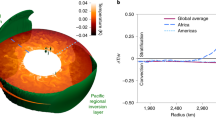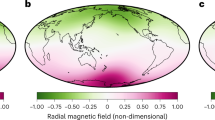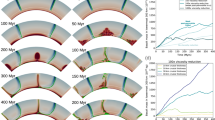Abstract
Seismic waves sampling the top 100 km of the Earth's inner core reveal that the eastern hemisphere (40° E–180° E) is seismically faster1,2, more isotropic2,3 and more attenuating4 than the western hemisphere. The origin of this hemispherical dichotomy is a challenging problem for our understanding of the Earth as a system of dynamically coupled layers. Previously, laboratory experiments have established that thermal control from the lower mantle can drastically affect fluid flow in the outer core5, which in turn can induce textural heterogeneity on the inner core solidification front6. The resulting texture should be consistent with other expected manifestations of thermal mantle control on the geodynamo, specifically magnetic flux concentrations7,8 in the time-average palaeomagnetic field9,10 over the past 5 Myr, and preferred eddy locations11 in flows imaged below the core–mantle boundary by the analysis of historical geomagnetic secular variation12. Here we show that a single model of thermochemical convection and dynamo action can account for all these effects by producing a large-scale, long-term outer core flow that couples the heterogeneity of the inner core with that of the lower mantle. The main feature of this thermochemical ‘wind’ is a cyclonic circulation below Asia, which concentrates magnetic field on the core–mantle boundary at the observed location and locally agrees with core flow images. This wind also causes anomalously high rates of light element release in the eastern hemisphere of the inner core boundary, suggesting that lateral seismic anomalies at the top of the inner core result from mantle-induced variations in its freezing rate.
This is a preview of subscription content, access via your institution
Access options
Subscribe to this journal
Receive 51 print issues and online access
$199.00 per year
only $3.90 per issue
Buy this article
- Purchase on Springer Link
- Instant access to full article PDF
Prices may be subject to local taxes which are calculated during checkout


Similar content being viewed by others
References
Niu, F. L. & Wen, L. X. Hemispherical variations in seismic velocity at the top of the Earth's inner core. Nature 410, 1081–1084 (2001)
Tanaka, S. & Hamaguchi, H. Degree one heterogeneity and hemispherical variation of anisotropy in the inner core from PKP(BC)-PKP(DF) times. J. Geophys. Res. 102, 2925–2938 (1997)
Yu, W. C. & Wen, L. X. Inner core attenuation anisotropy. Earth Planet. Sci. Lett. 245, 581–594 (2006)
Cao, A. & Romanowicz, B. Hemispherical transition of seismic attenuation at the top of the Earth's inner core. Earth Planet. Sci. Lett. 228, 243–253 (2004)
Sumita, I. & Olson, P. A laboratory model for convection in Earth's core driven by a thermally heterogeneous mantle. Science 286, 1547–1549 (1999)
Bergman, M. I., Macleod-Silberstein, M., Haskel, M., Chandler, B. & Akpan, N. A laboratory model for solidification of Earth's core. Phys. Earth Planet. Inter. 153, 150–164 (2005)
Olson, P. & Christensen, U. The time averaged magnetic field in numerical dynamos with non-uniform boundary heat flow. Geophys. J. Int. 151, 809–823 (2002)
Gubbins, D., Willis, A. P. & Sreenivasan, B. Correlation of Earth's magnetic field with lower mantle thermal and seismic structure. Phys. Earth Planet. Inter. 162, 256–260 (2007)
Johnson, C. L. & Constable, C. G. The time averaged geomagnetic field as recorded by lava flows over the past 5 Myr. Geophys. J. Int. 122, 489–519 (1995)
Kelly, P. & Gubbins, D. The geomagnetic field over the past 5 million years. Geophys. J. Int. 128, 315–330 (1997)
Aubert, J., Amit, H. & Hulot, G. Detecting thermal boundary control in surface flows from numerical dynamos. Phys. Earth Planet. Inter. 160, 143–156 (2007)
Amit, H. & Olson, P. Time average and time dependent parts of core flow. Phys. Earth Planet. Inter. 155, 120–139 (2006)
Lay, T., Hernlund, J., Garnero, E. J. & Thorne, M. S. A post-perovskite lens and D” heat flux beneath the central Pacific. Science 314, 1272–1276 (2006)
van der Hilst, R. et al. Seismostratigraphy and thermal structure of Earth's core-mantle boundary region. Science 315, 1813–1817 (2007)
Masters, G., Laske, G., Bolton, H. & Dziewonski, A. in Earth's Deep Interior: Mineral Physics and Tomography from the Atomic to the Global Scale (eds Karato, S., Forte, A., Liebermann, R. C., Masters, G. & Stixrude, L.) 63–87 (AGU Monogr. Vol. 117, American Geophysical Union, Washington DC, 2000)
van der Hilst, R., Widiyantoro, S. & Engdahl, E. R. Evidence for deep mantle circulation from global tomography. Nature 386, 578–584 (1997)
McNamara, A. K. & Zhong, S. J. Thermochemical structures beneath Africa and the Pacific Ocean. Nature 437, 1136–1139 (2005)
Torsvik, T. H., Smethurst, M. A., Burke, K. & Steinberger, B. Large igneous provinces generated from the margins of the large low-velocity provinces in the deep mantle. Geophys. J. Int. 167, 1447–1460 (2006)
Labrosse, S., Poirier, J. P. & Le Mouel, J. L. The age of the inner core. Earth Planet. Sci. Lett. 190, 111–123 (2001)
Braginsky, S. I. & Roberts, P. H. Equations governing convection in Earth’s core and the geodynamo. Geophys. Astrophys. Fluid Dyn. 79, 1–97 (1995)
Christensen, U. & Aubert, J. Scaling properties of convection-driven dynamos in rotating spherical shells and application to planetary magnetic fields. Geophys. J. Int. 117, 97–114 (2006)
Olson, P., Christensen, U. & Glatzmaier, G. A. Numerical modelling of the geodynamo: Mechanisms of field generation and equilibration. J. Geophys. Res. 104, 10383–10404 (1999)
Yoshida, S., Sumita, I. & Kumazawa, M. Growth model of the inner core coupled with the outer core dynamics and the resulting elastic anisotropy. J. Geophys. Res. 101, 28085–28103 (1996)
Bergman, M. I., Agrawal, S., Carter, M. & Macleod-Silberstein, M. Transverse solidification textures in hexagonal close-packed alloys. J. Cryst. Growth 255, 204–211 (2003)
Cormier, V. Texture of the uppermost inner core from forward and back scattered seismic waves. Earth Planet. Sci. Lett. 258, 442–453 (2007)
Buffett, B. A. & Glatzmaier, G. A. Gravitational braking of inner-core rotation in geodynamo simulations. Geophys. Res. Lett. 27, 3125–3128 (2000)
Mound, J. E. & Buffett, B. A. Detection of a gravitational oscillation in length-of-day. Earth Planet. Sci. Lett. 243, 383–389 (2006)
Aurnou, J. & Olson, P. Control of inner core rotation by electromagnetic, gravitational and mechanical torques. Phys. Earth Planet. Inter. 117, 111–121 (2000)
Dumberry, M. Geodynamic constraints on the steady and time-dependent inner core axial rotation. Geophys. J. Int. 170, 886–895 (2007)
Souriau, A. in Treatise on Geophysics Vol. 1, Seismology and Structure of the Earth (eds Dziewonski, A. & Romanowicz, B.) 655–693 (Elsevier, 2007)
Wicht, J. Inner-core conductivity in numerical dynamo simulations. Phys. Earth Planet. Inter. 132, 281–302 (2002)
Lister, J. R. & Buffett, B. A. The strength and efficiency of thermal and compositional convection in the geodynamo. Phys. Earth Planet. Inter. 91, 17–30 (1995)
Secco, R. A. & Shloessin, H. H. The electrical resistivity of solid and liquid Fe at pressures up to 7 GPa. J. Geophys. Res. 94, 5887–5894 (1989)
Acknowledgements
J.A. was supported by the SEDIT programme of CNRS-INSU. H.A. was supported by a Marie Curie intra-European grant. Numerical calculations were performed at the Service de Calcul Parallèle, IPGP, and at IDRIS, France. We thank S. Tanaka for providing published data, and V. Cormier for discussions. This is IPGP contribution 2369.
Author information
Authors and Affiliations
Corresponding author
Supplementary information
Supplementary information
The file contains Supplementary Discussion and Supplementary Figure 1.with Legend. The file includes information about model assumptions, scaling relationships and the choice of model parameters. (PDF 1424 kb)
PowerPoint slides
Rights and permissions
About this article
Cite this article
Aubert, J., Amit, H., Hulot, G. et al. Thermochemical flows couple the Earth's inner core growth to mantle heterogeneity. Nature 454, 758–761 (2008). https://doi.org/10.1038/nature07109
Received:
Accepted:
Issue Date:
DOI: https://doi.org/10.1038/nature07109
This article is cited by
-
Enhanced inner core fine-scale heterogeneity towards Earth’s centre
Nature (2023)
-
Small-scale layered structures at the inner core boundary
Nature Communications (2023)
-
Superionic effect and anisotropic texture in Earth’s inner core driven by geomagnetic field
Nature Communications (2023)
-
Transient variation in seismic wave speed points to fast fluid movement in the Earth's outer core
Communications Earth & Environment (2022)
-
An initial map of fine-scale heterogeneity in the Earth’s inner core
Nature Geoscience (2022)
Comments
By submitting a comment you agree to abide by our Terms and Community Guidelines. If you find something abusive or that does not comply with our terms or guidelines please flag it as inappropriate.



